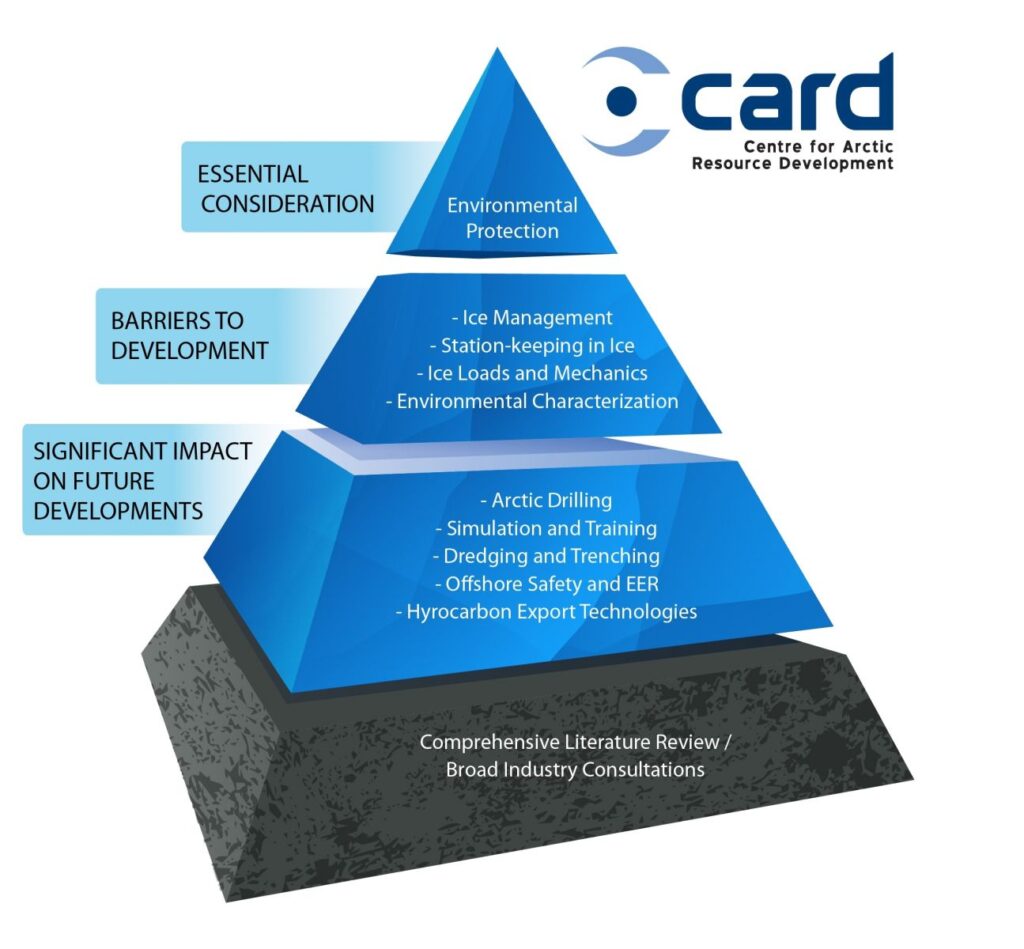CARD’s Arctic Development Roadmap (ADR) project identified, organized and prioritized key R&D issues requiring work to advance knowledge, technology, methodology, and training needed for Arctic oil and gas development. Based on in-depth reviews of previous gap analyses and current technology, as well as broad consultation with industry, issues were ranked according to: current state of knowledge and technology, impact of further R&D, extent of applicability, relevance to the industry, and anticipated timeframe to achieve result.

This project informed CARD’s Five-Year Research Plan. The pyramid figure illustrates the R&D priorities which emerged from the ADR process, which are:
ENVIRONMENTAL PROTECTION
including oil spill prevention and response; emissions, pollution, noise and environmental footprint; and the need to ensure same-season well control under all conditions.
ICE MANAGEMENT
including physical management of very large icebergs, ice islands, and multi-year ice in both open water and pack ice conditions; improved management strategies for small, thick multi-year floes embedded in first-year ice; research to improve the capacity of ice management to extend operating seasons; and the need for tools to support effective decision-making for complex multi-vessel, multi-input operational environments and logistical models to simulate the whole ice management system.
ICE MECHANICS AND LOADING
principally, the development of improved design methods based on a more complete understanding of ice failure processes and associated mechanics.
STATION-KEEPING IN ICE
including improved understanding and modelling of ice loads on floating platforms, and robustly designed disconnect systems to allow for reliable, routine operational use under heavy ice loads and streamlined re-connection methods.
ENVIRONMENTAL CHARACTERIZATION
including technology that can rapidly and accurately measure environmental data both for design and real-time operations; further characterization of regional ice and metocean conditions to support improved design of bottom-founded and floating structures; and compilation of statistical information on first-year and multi-year ice thickness, floe size, drift speed, strength, ridge dimensions and ridge densities within floes.
OFFSHORE SAFETY AND ESCAPE, EVACUATION, AND RESCUE (EER)
including the need to design and validate performance of ice-capable evacuation systems, man-over-board rescue technology and technologies to limit outdoor work time in Arctic conditions; defined requirements for rescue and medical treatment; improved simulation, training and decision-making tools for evacuation scenarios; and updated standards and regulations based on new research and technological developments.
DREDGING AND TRENCHING
including design and development of improved dredging and trenching technologies for harsh Arctic metocean, ice, and geotechnical conditions; R&D to reduce the cost of operations, reduce the required burial depth or produce better trenches for Arctic pipelines, particularly through improved understanding of iceberg scour patterns, frequencies and loads; methods for managment and disposal of dredged-up sediment and for lowering equipment through various ice conditions; and understanding and mitigation of the effect of dredging/trenching sound and sediment emissions on subsea ecosystems and mammals.
SIMULATION AND TRAINING
including simulation and training technology for EER scenarios, as well as for oil spill response scenarios.
HYDROCARBON EXPORT TECHNOLOGIES
including advancement of Floating Liquid Natural Gas (FLNG) technology for stranded gas exploitation.
ARCTIC DRILLING
principally, methods and technologies to extend the drilling season through advances in support technology, and/or decreasing the time required to drill a well through advances in drilling technology.
Provided here is merely a summary of the process and results. Click here to read the Arctic Development Roadmap.